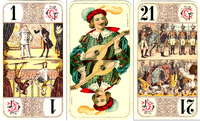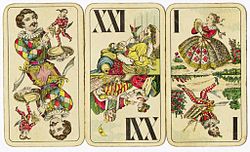
A trick-taking game is a card or tile-based game in which play of a hand centers on a series of finite rounds or units of play, called tricks, which are each evaluated to determine a winner or taker of that trick. The object of such games then may be closely tied to the number of tricks taken, as in plain-trick games such as Whist, Contract bridge, Spades, Napoleon, Euchre, Rowboat, Clubs and Spoil Five, or to the value of the cards contained in taken tricks, as in point-trick games such as Pinochle, the Tarot family, Mariage, Rook, All Fours, Manille, Briscola, and most evasion games like Hearts. The domino game Texas 42 is an example of a trick-taking game that is not a card game. Trick-and-draw games are trick-taking games in which the players can fill up their hands after each trick. In most variants, players are free to play any card into a trick in the first phase of the game, but must follow suit as soon as the stock is depleted. Trick-avoidance games like Reversis or Polignac are those in which the aim is to avoid taking some or all tricks.

Tarocchini are point trick-taking tarot card games popular in the Bologna region of Italy and has been confined mostly to this area. They are the diminutive form of tarocchi, referring to the reduction of the Bolognese pack from 78 to 62 cards, which probably occurred in the early 16th century.

Spades is a trick-taking card game devised in the United States in the 1930s. It can be played as either a partnership or solo/"cutthroat" game. The object is to take the number of tricks that were bid before play of the hand began. Spades is a descendant of the Whist family of card games, which also includes Bridge, Hearts, and Oh Hell. Its major difference as compared to other Whist variants is that, instead of trump being decided by the highest bidder or at random, the Spade suit always trumps, hence the name.
Pedreaux is an American trick-taking card game of the All Fours family based on Auction Pitch. Its most popular variant is known as Cinch, Double Pedro or High Five. Developed in Denver, Colorado, in the 1880s, it was soon regarded as the most important member of the All Fours family. Although it went out of fashion with the rise of Auction Bridge, it is still widely played on the western coast of the United States and in its southern states, being the dominant game in some locations in Louisiana. Forms of the game have been reported from Nicaragua, the Azores, Italy and Finland. The game is primarily played by four players in fixed partnerships, but can also be played by 2–6 individual players.
Minchiate is an early 16th-century card game, originating in Florence, Italy. It is no longer widely played. Minchiate can also refer to the special deck of 97 playing cards used in the game. The deck is closely related to the tarot cards, but contains an expanded suit of trumps. The game was similar to but more complex than tarocchi. The minchiate represents a Florentine variant on the original game.
A trump is a playing card which is elevated above its usual rank in trick-taking games. Typically, an entire suit is nominated as a trump suit; these cards then outrank all cards of plain (non-trump) suits. In other contexts, the terms trump card or to trump can refer to any sort of action, authority, or policy which automatically prevails over all others.
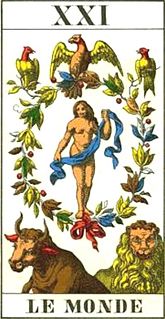
Troccas is a member of the Tarot family of card games. It is played in the Romansh speaking part of the canton Grisons of Switzerland. It is not known exactly how this game entered Switzerland but it is generally thought to have arrived from Italy during the 17th century.

Cego or Baden Tarock, also called Ceco, is a tarot card game played mainly in the Upper Rhine valley, the Black Forest, the adjacent Baar lowland and around Lake Constance in Switzerland and Austria. The game is similar to Königrufen and Tapp-Tarock. It is distinguished by a large skat, or talon, called "the Blind".
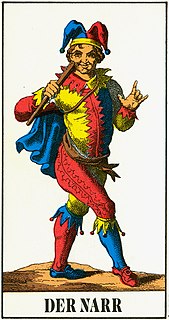
Troggu is a member of the tarot family of card games. Synonyms for the games name are: Trogga, Tappu and Tappä. It is played in the area of Visp, Switzerland, in Upper Wallis, especially in St. Niklaus and Grächen. After Troccas, it is the second most played tarot card game in Switzerland.
Smear is a North-American trick-taking card game of the All Fours group, and a variant of Pitch (Setback). Several slightly different versions are played in the Upper Peninsula of Michigan, Minnesota, Northern and Central Iowa, Wisconsin and also in Ontario, Canada.

The following is a glossary of terms used in card games. Besides the terms listed here, there are thousands of common and uncommon slang terms. Terms in this glossary should apply to a wide range of card games. For glossaries that are specific to one game, see Game-specific glossaries.

Tarot games are card games played with tarot decks, that is, decks with numbered persistent trumps parallel to the suit cards. The games and decks which English-speakers call by the French name Tarot are called Tarocchi in the original Italian, Tarock in German and various similar words in other languages. The basic rules first appeared in the manuscript of Martiano da Tortona, written before 1425. The games are known in many variations, mostly cultural and regional.
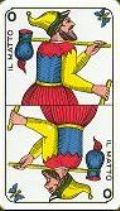
Scarto is a three player trick-taking tarot card game from Piedmont, Italy. It is a simple tarot game which can serve as an introduction to more complex tarot games. The name comes from the discarded cards that were exchanged with the stock, which is also the origin of the name for the Skat card game.

Tapp Tarock, also called Viennese Tappen, Tappen or Tapper, is a three-player tarot card game which traditionally uses the 54-card Industrie und Glück deck. This is an introductory game for more complex tarock games like Cego or Königrufen. During the interwar period, it was the preferred card game of Viennese coffee houses. Even today Tapp Tarock is played sporadically. The exact date when it appeared is not possible to identify; some sources suggest may have been developed in Austria in the early 19th century, but its mention in a 'caricature opera' in 1806 suggest it was well known even by then and may well have arisen in the late 18th century. The oldest description of the rules is dated to 1821.

The Fool or The Jester is one of the 78 cards in a Tarot deck. In occult tarot, it is one of the 22 Major Arcana, sometimes numbered as 0 or XXII. However, in decks designed for playing traditional Tarot card games, it is typically unnumbered, as it is not one of the 21 trump cards and instead serves a unique purpose by itself.

Bauerntarock also called Brixentaler Bauerntarock, is a point-trick card game played in the Brixental, Austria. It may have originated in the 19th century as an adaptation of the 54-card Tapp Tarock game onto the cheaper and smaller 36-card German deck. Another possibility is that it was adapted from the 78-card Tarok-Ombre game as the ratio of trumps to non-trumps is almost the same. It uses the Skat Schedule found in popular regional games such as Jass and Schafkopf. It is closely related to Bavarian Tarock, Württemberg Tarock, and especially Dobbm. Like Bavarian Tarock and Tapp, Brixental Bauerntarock and Dobbm do not belong to the true tarot games, but have adopted rules from Tapp Tarock. The most fundamental difference between these games and true tarot games is in the use of German or French decks instead of true Tarot playing cards.
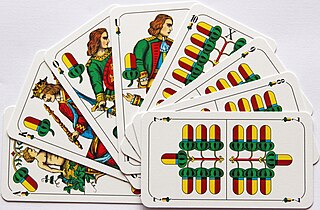
Bavarian Tarock, Haferltarock or, often, just Tarock, is a card game played in Bavaria and several regions of Austria as well as in Berlin. The name is a clue to its origin as an attempt to design a game resembling Tapp Tarock but without using a Tarock pack. The original form of Bavarian Tarock thus incorporated several elements of the true Tarock games, whilst being played with a 36-card German deck. However, during the last century, it has evolved into "quite a fine game" that, however, has less in common with its Tarock progenitor. It is descended from Tapp Tarock via the very similar game of Tapp, played in Württemberg, and is thus related to Bauerntarock, Frog and Dobbm. It should not be confused with Königrufen, also known as Austrian Tarock or just Tarock.

The trull is a trio of three special trump cards used in tarock games in Austria and other countries that have a much higher card value than the other trumps. The individual cards are known as trull cards (Trullstücke). The word trull is derived from the French tous les trois which means "all three".

Point Tarock, also known as Illustrated Tapp, is a three-player tarot card game, played mainly in Austria, which uses the 54-card Industrie und Glück deck. Furr describes it as being "identical to Tapp but for the addition of a special announcement, allowing a Declarer to capitalize on a very good hand... spicing up the game considerably." Point Tarock is sometimes confused with its close cousin, Illustrated Tarock.
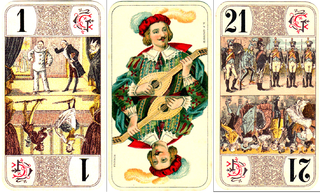
Droggn is an extinct card game from the Austrian branch of the Tarock family for three players that was played in the Stubai valley in Tyrol, Austria until the 1980s. Droggn is originally local dialect for "to play Tarock", but it has become the proper name of this specific Tarock variant. An unusual feature of the game compared with other Tarock games is the use of a 66-card deck and that there is no record in the literature of a 66-card game and no current manufacturers of a such a deck. The structure of the game strongly indicates that it is descended from the later version of Tarok L'Hombre, a 78-card Tarock game popular in 19th-century Austria and Germany, but with the subsequent addition of two higher bids.
